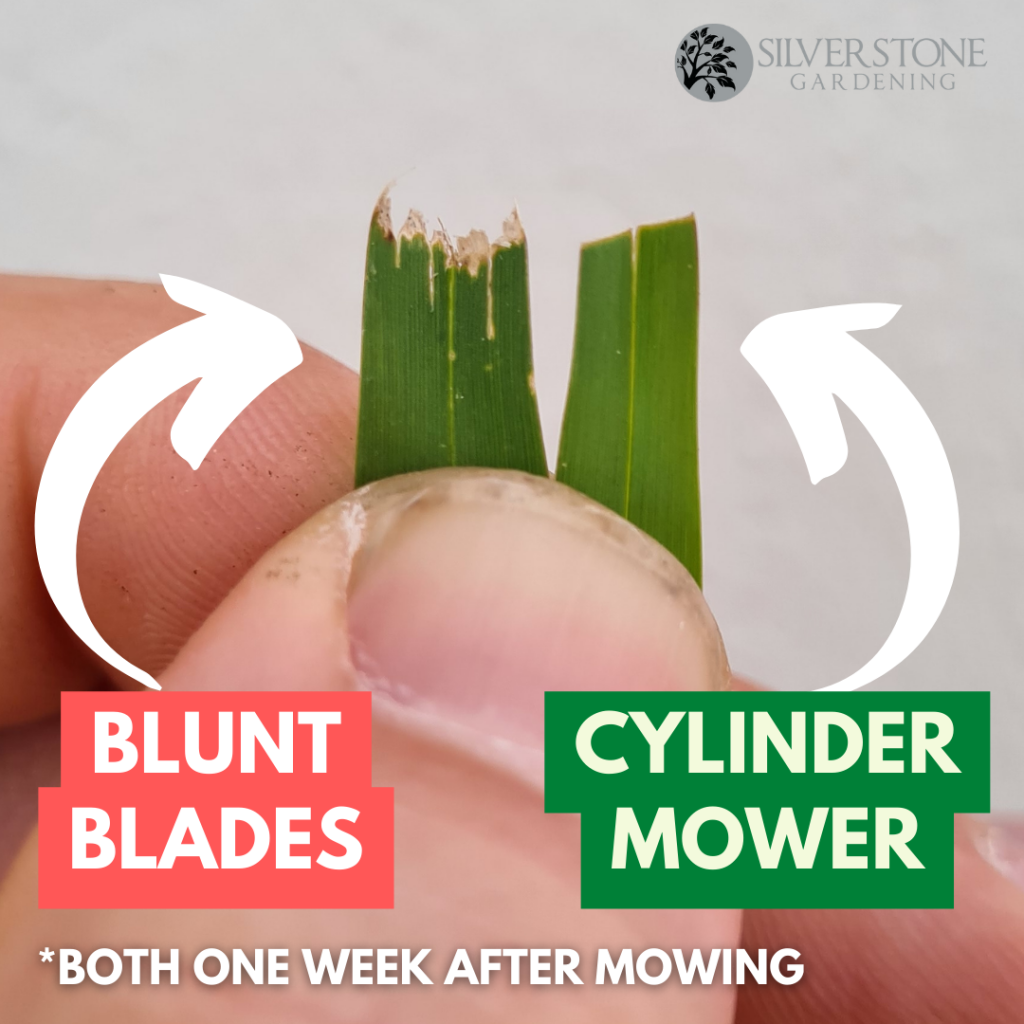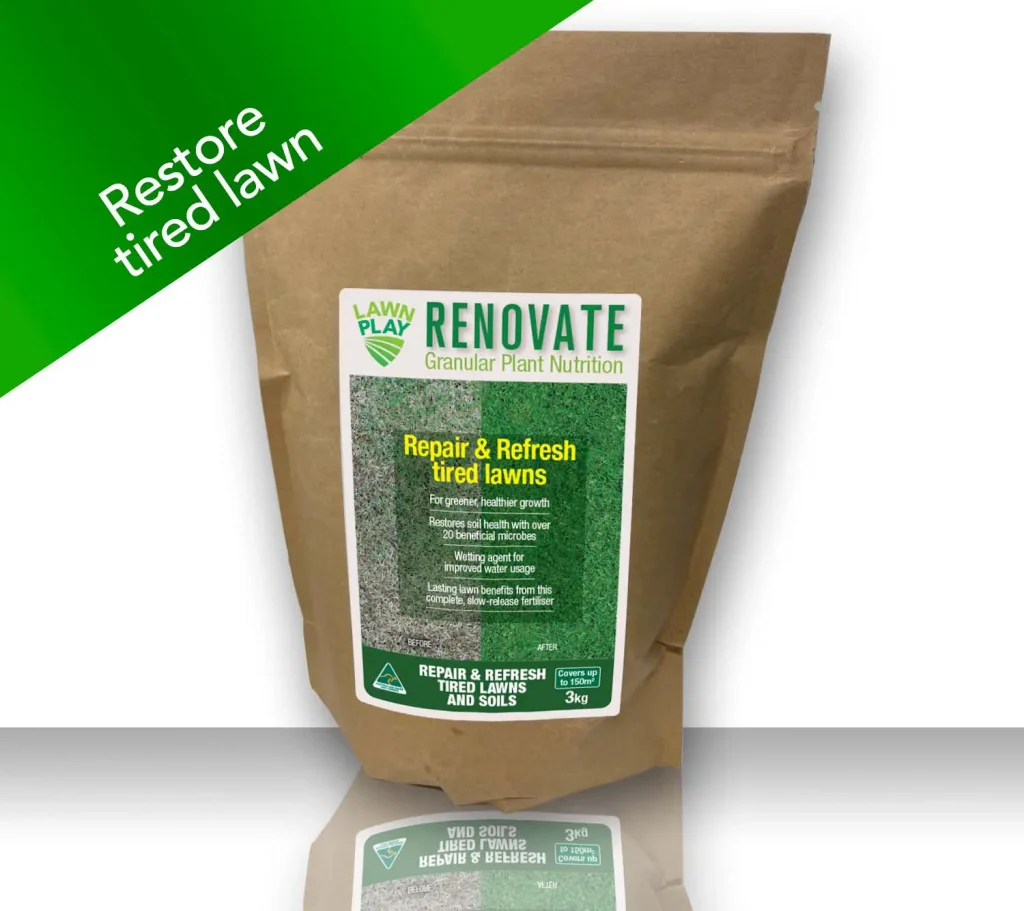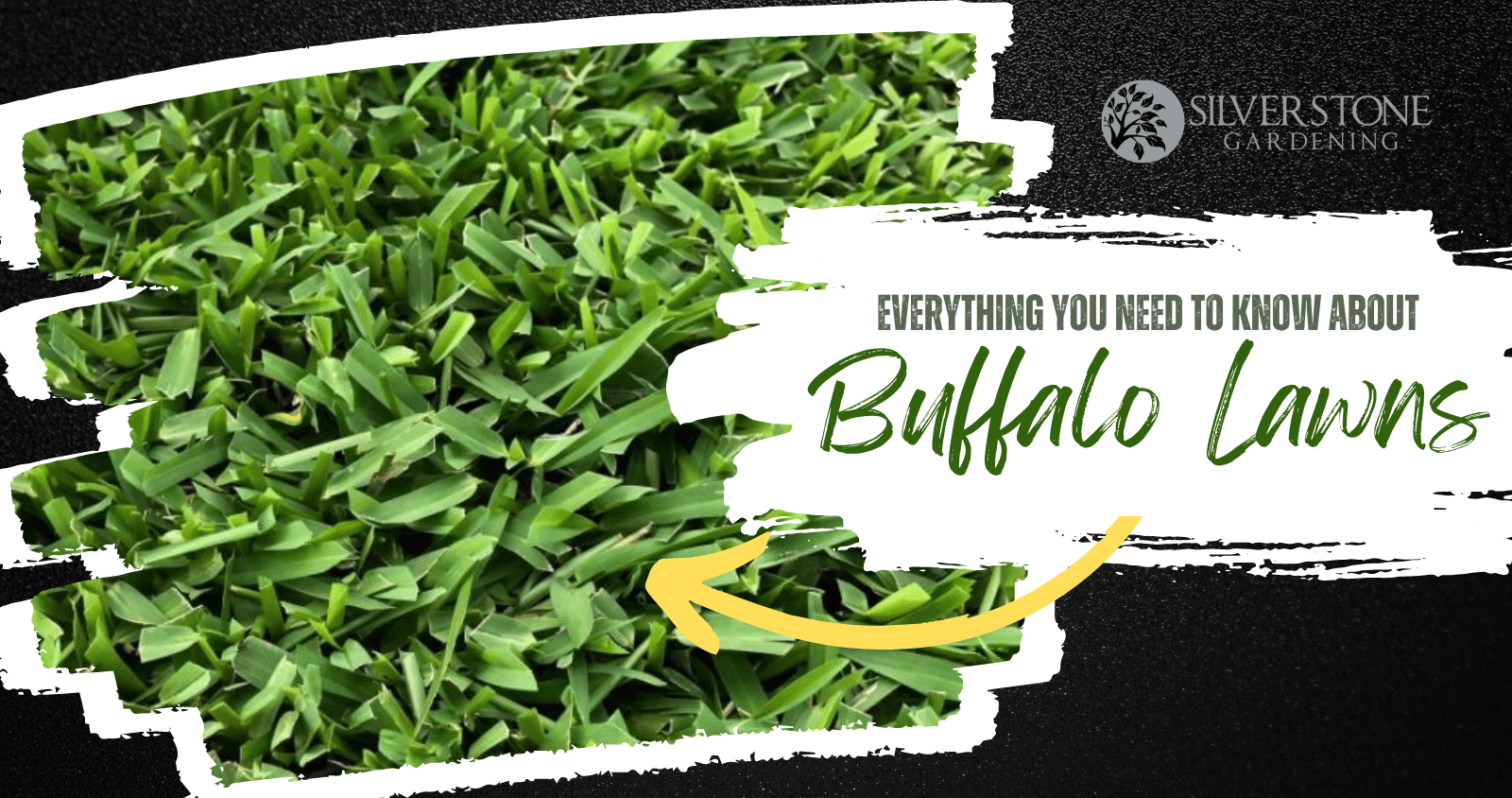
The Basics Of Buffalo Lawns
Buffalo lawns are a popular choice among Australian homeowners, thanks to their ability to tolerate heat, drought and shady conditions whilst still looking great. It is also known as a low maintenance lawn Buffalo grass is known for its unique characteristics such as broad leaves, dense growth, and a deep green colour.
It is a very popular lawn in Australia. If you are considering buying Buffalo lawn for your home, or are looking for a great maintenance guide, then we are here to help.
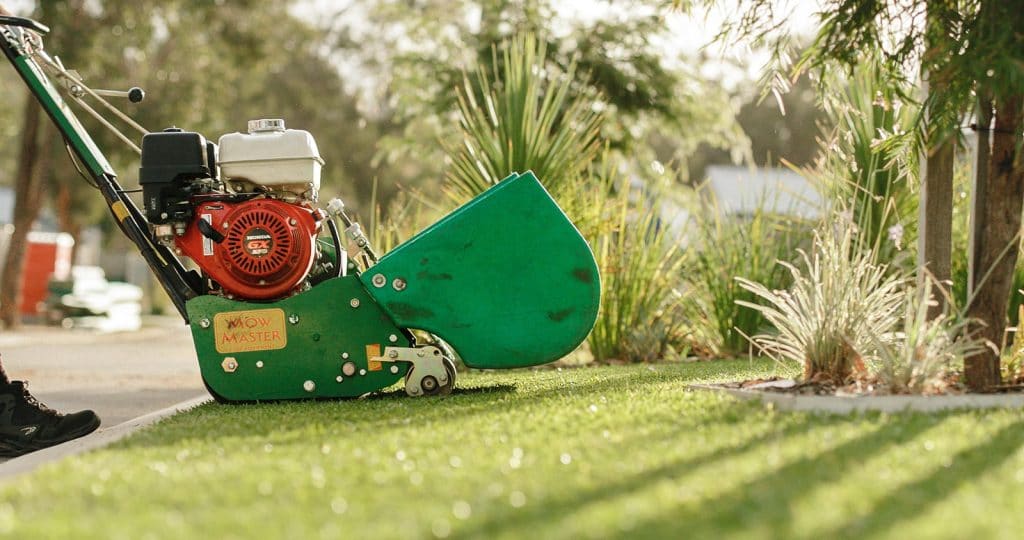
4 Common Varieties of Buffalo Lawns
There are various types of buffalo lawn in Australia, with different breeding programs aimed at developing varieties that are more resistant to certain conditions. Here are the five most popular varieties:
- Sir Walter: This variety is one of the most popular buffalo grasses in Australia. It was bred in Australia and is known for its soft leaf and superior shade tolerance.
Click here for more information on Sir Walter. - Palmetto: This variety is another popular choice due to its ability to tolerate both heat and cold. It was developed in the USA, and was introduced to Australia in the early 2000s.
Click here for more information on Palmetto. - Matilda: This variety is bred in Australia, and is known for its fine texture and attractive blue-green colour. It is also highly resistant to drought and disease.
Click here for more information on Matilda. - Sapphire: This variety was bred in Australia and is popular for its deep green colour and soft texture. It is also highly resistant to wear and tear.
Click here for more information on Sapphire.
The differences between these varieties of Buffalo lawns are more subtle than the differences between different species of lawn like Buffalo and Couch lawns for example. However, these subtle differences may make all the difference depending on your specific circumstance. Some have been bred for their ability to tolerate shade, others for their soft texture, and some for their resistance to drought and disease.
Overall, buffalo lawns offer a low maintenance, hard-wearing and aesthetically pleasing option for homeowners in Australia.
Three strengths of Buffalo lawns
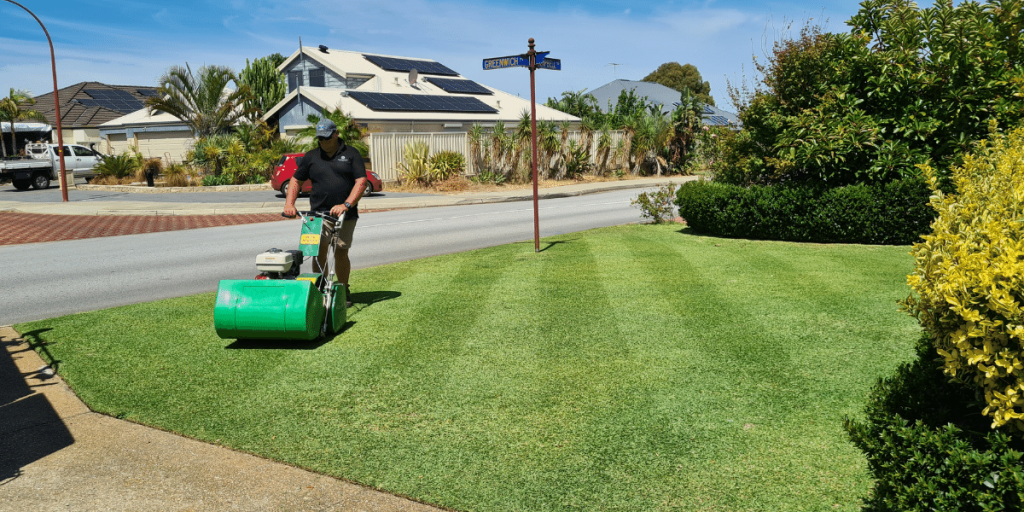
Buffalo lawns offer several advantages over other popular lawn varieties like Couch, Kikuyu and Zoysia. Here are three key positives of Buffalo lawns:
- Low Maintenance: Buffalo grass is known for its low maintenance requirements. It has a deep root system that allows it to access water and nutrients from deep within the soil, reducing the need for frequent watering and fertilisation. Buffalo grass also has a dense growth pattern that helps to prevent weed growth, reducing the need for herbicides.
When compared to Couch and especially Kikuyu, Buffalo requires less mowing (a similar amount to Zoysia), and is much less invasive into garden beds. - Shade Tolerance: One of the major benefits of buffalo grass is its shade tolerance. Buffalo grass, like Zoysia, is a great option for areas with partial shade, making it an ideal choice for gardens with trees or structures that cast shadows. Compared to Couch and Kikuyu, Buffalo grass can maintain its colour and growth even in low-light conditions, making it a popular choice for many Australian homeowners.
- Drought Tolerance: Buffalo grass is highly drought tolerant, making it an ideal choice for areas with low rainfall or water restrictions. Its deep root system allows it to access water from deep within the soil, enabling it to survive periods of extended drought. This characteristic makes buffalo grass a popular choice for homeowners who are looking for a low-maintenance, water-wise option for their lawn.
Overall, buffalo grass is a great option for those looking for a low maintenance, shade and drought tolerant lawn. While other grass varieties like Couch, Kikuyu and Zoysia have their own advantages, buffalo grass is often preferred for its resilience and ease of care.
3 weaknesses of Buffalo lawns

While there are several advantages to using Buffalo grass as a lawn variety, there are also some potential drawbacks that homeowners should be aware of. Here are three negatives of Buffalo lawns:
- Slow Recovery from Damage: One of the primary drawbacks of Buffalo grass is its slow recovery from damage. Buffalo grass is a slow-growing variety, which means it can take longer to repair itself after being damaged by heavy foot traffic, pets, or other factors. This can be particularly problematic with dogs that are prone to digging or in high-traffic areas, where the grass may not be able to recover quickly enough to prevent bare patches from forming.
- Lack of Colour in Colder Climates: Buffalo grass is known for its deep green colour, but this colour can fade in colder climates. In areas where temperatures regularly dip below freezing, Buffalo grass may lose its vibrant colour and turn brown or yellow. This can be a concern for homeowners who are looking for a lawn that maintains its colour year-round.
Even in areas with more mild winters Buffalo lawns will need extra fertilisation and maintenance to maintain a beautiful, green colour. - Not for low cut lawn: Whilst Buffalo has a lot of strengths it is not suitable as a low cut lawn. Couch, Zoysia and even Kikuyu lawns can be maintained under 10mm, with the right maintenance practices. However, Buffalo lawns start to lose a lot of colour and wear resistance the lower they. If you are looking for a lawn maintained below 10mm, Buffalo is not the best option.
In summary, while Buffalo grass has many benefits, it may not be the best choice for all settings. Homeowners should consider factors like climate, foot traffic, and maintenance requirements when choosing a grass variety for their lawn. If Buffalo grass is not suitable for a particular setting, there are many other grass varieties available that may be a better fit.
How to maintain buffalo lawns.
What height should you cut buffalo lawn?

Here is the simple answer. In most cases a Buffalo lawn cut with a rotary mower will do well if cut around 40-60mm and a Buffalo lawn cut with a cylinder mower will do well between 15-30mm. However, there is no “one size fits all” height of cut for Buffalo lawn, there needs to be more information considered.
The ideal height for cutting a Buffalo lawn will depend on the variety of Buffalo grass you have, the type of mower you have and the specific growing conditions in your area. For example, if your lawn is heavily shaded it should be cut higher than if it receives full sun. In addition if you are cutting the lawn with a cylinder mower you can maintain the lawn at a lower height of cut than someone using a rotary mower.
Cylinder mowers give a much cleaner quality of cut, as pictured below. Rotary mowers, especially when they have blunt blades, “fray” the lawn blades. This means that rotary mowers often leave a white tinge over the lawn, which gets worse the lower the lawn is cut.
When mowing a Buffalo lawn, it’s important to follow the “one-third rule.” This means that you should never cut more than one-third of the grass blade at a time. For example, if your grass is 50mm tall, a regular maintenance cut shouldn’t remove more than 16mm from the lawn. Cutting more than one-third of the blade can also put stress on the lawn and lead to damage.
What happens to Buffalo lawns cut too short or too long?

When cutting Buffalo, or any other lawn, we always want to avoid scalping the lawn, which is when your mower cuts into the white/brown thatch layer, or even down to the dirt. This causes damage to the lawn and often causes weeds to grow into the scalped patches. However, even if you don’t scalp you can still cause two issues when cutting Buffalo too short.
The first issue that you may have noticed is that it is common when cutting buffalo too short to cause excess lateral runners (stolons) to grow across the lawns surface. These runners make the lawn look untidy and require extra maintenance to clear up (more about this here).
The second issue when cutting too short is simply a loss of colour. Buffalo has a beautiful, dark green colour when cut at the right height, but cutting it too short will lead to a lighter green/tan colour to the turf.

On the other hand, allowing the grass to grow too tall can make your Buffalo lawn difficult to mow and can lead to a less attractive lawn. Over time these lawns become thatch and require vertimowing.
How often should you mow buffalo lawn?
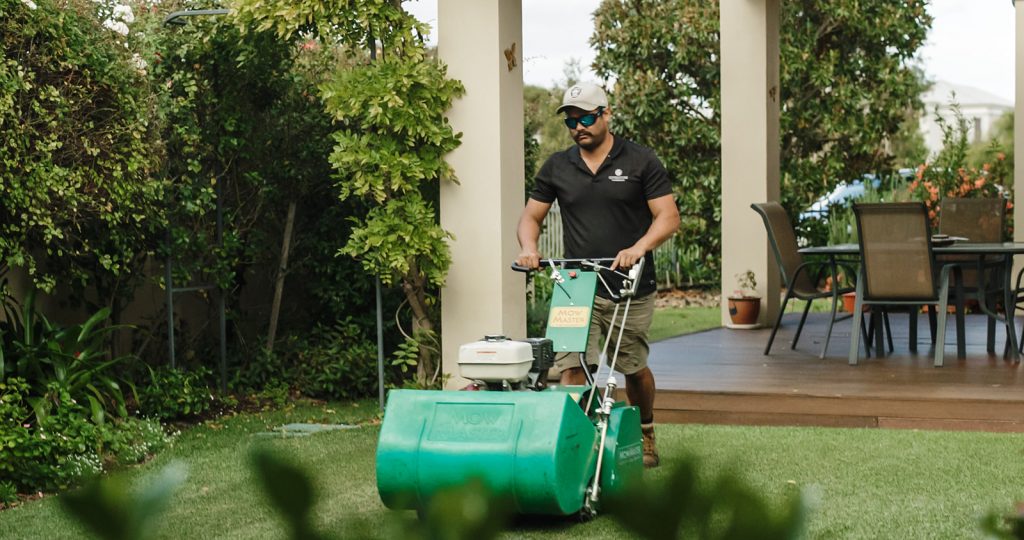
The frequency of mowing a Buffalo lawn depends on several factors, including the time of year and the grass height. As mentioned before the goal with mowing is to never remove more and one third of the leaf in a regular maintenance cut. So we will give two guides, a guide for higher cut lawns with a rotary mower (40-60mm) and lower cut lawns with a cylinder mower (15-30mm).
Higher Cut Lawns (40-60mm) Rotary Mower: During the growing season (typically September-April for most places in Australia) these lawns will need to be cut around every 1-2 weeks, and every 3-4 weeks during the colder months (typically May-August).
Lower Cut Lawns (15-30mm) Cylinder Mower: During the growing season (typically September-April for most places in Australia) these lawns will need to be cut weekly and occasionally twice weekly, and every 2-3 weeks during the colder months (typically May-August).
How much water do buffalo lawn need each week?
The amount of water required for a Buffalo lawn will depend on several factors, including the climate, soil type, and the age of the lawn. As a general rule, a Buffalo lawn will require around 20-30mm of water per week during the growing season.
However, less water will be required in lawns grown in higher quality soils, and lawns that are regularly aerated and have fertiliser and wetting agents applied.
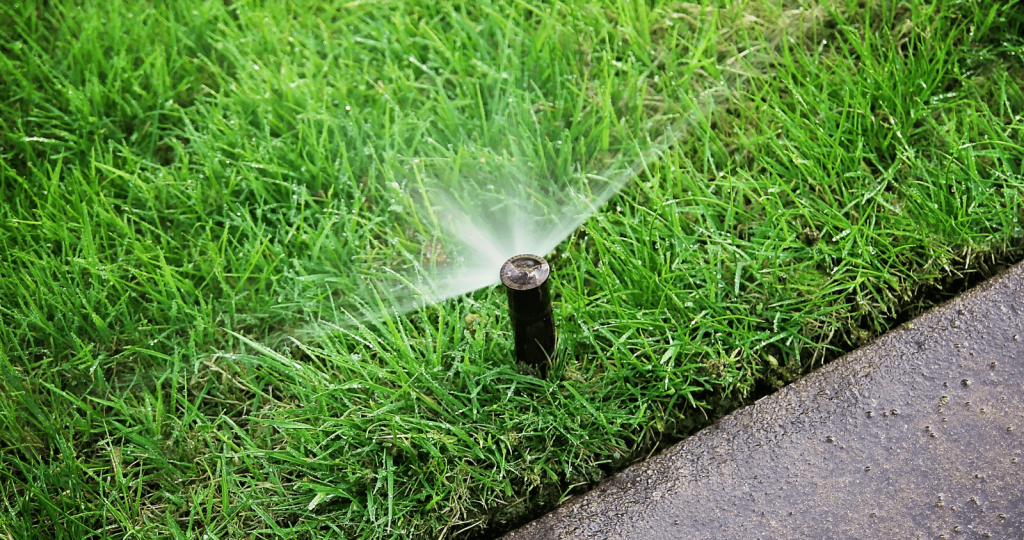
It’s important to note that over watering a Buffalo lawn can also harmful. Too much water and too frequent watering can lead to shallow root growth, which actually causes Buffalo lawns to become less resilient in hot weather and can also increase the risk of fungal disease.
If you live in an area with water restrictions, you may need to adjust your watering schedule accordingly. In general, it’s best to water your Buffalo lawn deeply and infrequently, rather than applying frequent shallow waterings. This will help to promote deep root growth and a healthier, more resilient lawn.
What is the best fertiliser for Buffalo?

The best specific fertiliser for your Buffalo lawn will depend on the time of year, the goal you have for your lawns and the starting state of your lawn. So there is no such thing as a one size fits all fertiliser. So, with that said here are the products that we use, and what situations we use them in.
Best fertiliser for rapid Buffalo recovery: Lawn Play Renovate
Renovate has high rate of carbon coated nitrogen. This results in rapid growth.
It also has a full spectrum of trace elements with helps with the overall health of the plant.
If you have a patchy lawn, or your lawn has lost vigor and colour then this is a great option. Just remember that Buffalo is naturally slower at recovering than Couch or Kikuyu.
Click here to read more.
Increase Buffalo Colour Without Increasing Growth: Lawnganics Brilliance
A common mistake I see is when a lawn is fairly healthy, is for people to put down a high nitrogen fertiliser at a high rate when they start to notice a drop in colour (as this is often what they used to get the lawn looking great in the past).
The problem is that the nitrogen then causes too much excessive growth. This leads to a thatchy lawn that is easy to scalp.
Brilliance is a liquid fertiliser that has a very low rate of nitrogen and a high rate of iron. This will cause a rapid greening of the lawn but only minimal extra growth.
Click here to read more.
Slow Release Fertiliser For Healthy Buffalo Lawns: Lawn Play All Rounder
Slow release fertilisers are the best fertilisers for most Aussie households. Whilst they are not as good at repairing a tired lawn, they are fantastic at maintaining healthy lawns (especially for busy lawn lovers).
All Rounder has two forms of slow release nitrogen so it can last around 2-3 months per application. It also includes a full spectrum of trace elements which is great for lawns overall health.
Click here to read more.
Encourage Root Growth in Buffalo Lawns: Lawnganics Roots
Encouraging deep root is very important to Buffalo lawns, especially in hot areas.
Roots is a combination of organic fertilisers and soil health stimulants like mycorrhizal fungi, humates and kelp that help promote root growth.
Click here to read more.
There are a whole host of fertilisers that a suitable to use on Buffalo lawns here. We use and recommend products from The Lawn Shed all the time.
How often should buffalo lawn be fertilised?
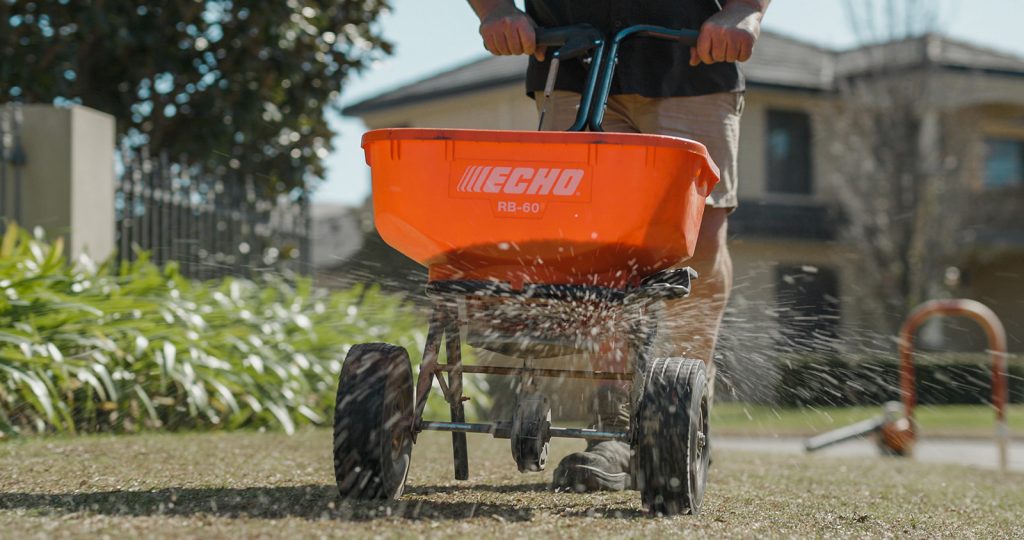
The frequency of fertilisation for a Buffalo lawn will depend on the type of fertiliser used, the specific variety of Buffalo grass your have, the quality of your soil, and the overall health of the lawn.
Generally speaking, a Buffalo lawn grown in a healthy soil may only need 2-4 applications of slow-release fertiliser a year. A Buffalo lawn in a poor quality, sandy soil will likely need fertilising every 6-10 weeks in the growing season with granule fertiliser, and every 2-4 weeks with liquid fertiliser during the colder months.
It’s important not to over-fertilise a Buffalo lawn, as this can lead to excessive growth, thatch build-up, and increased risk of pests and disease. Over-fertilising can also harm the environment by contributing to nutrient runoff and pollution.
How do you get rid of runners (stolons) on Buffalo lawns?

Buffalo grass is known for its aggressive runners or stolons, which can quickly spread and create a thick, lush lawn. However, in low cut lawns it is common for these runners to start to grow laterally across the surface of the lawn, which can become rather unsightly.
If you have a very small lawn, you can simply pull these out by hand. However, for most lawns the easiest way to control runners on a Buffalo lawn is through a practice called lawn grooming. Lawn grooming involves using a specialised mower, called a vertimower (sometimes called a scarifier, or groomer) which is simply a mower that has vertical blades.
To remove the unsightly runners simply set the height of the vertimower blades to lightly touch the surface of the lawn. Once you get the height of the vertimower right you will be able run the vertimower over the whole lawn to lightly remove most of the unsightly runners without causing too much damage to the rest of the lawn.

It’s important to note that while lawn grooming can help to control runners, it should be done with care to avoid damaging the lawn. Over-grooming can lead to stress on the grass and make it more susceptible to pests and disease. It’s also important to follow the manufacturer’s instructions for your grooming tool and avoid using it too frequently or aggressively.
Can Buffalo lawns be vertimowed?
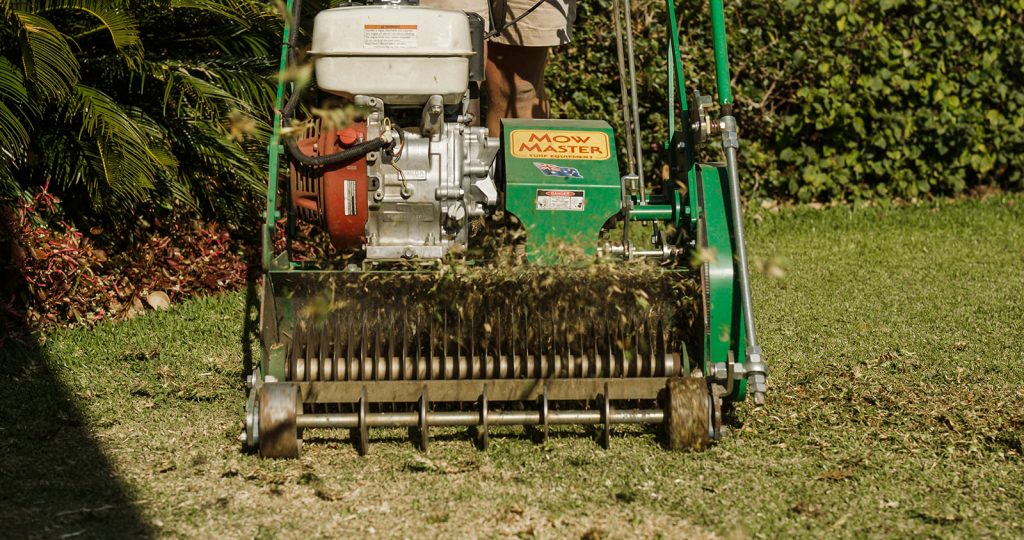
Buffalo lawns can be vertimowed, but it should be done with caution and only in certain situations. Vertimowing is a lawn grooming technique that involves using a vertical mower (also known as a scarifier or dethatcher) to remove excess thatch and promote healthy grass growth.
While vertimowing can be beneficial for some types of grass, it can be damaging to Buffalo grass if done improperly. This is because, unlike Kikuyu or Couch, Buffalo does not have an rhizomes, which are lawn runners that grow under the soil. This means that if you are too aggressive with your vertimowing you may removal all the surface runners, which results in areas of your lawn that will not recover properly.
If you do choose to vertimow your Buffalo lawn, it’s important to follow these guidelines:
- Only vertimow when the grass is actively growing and can recover quickly from the process.
- Adjust the height of the verticutter blades so that they are just touching the surface of the soil. This will help to remove excess thatch without damaging the runners.
- Don’t vertimow too frequently. Overuse of a vertical mower can cause stress on the grass and lead to long-term damage.
- After vertimowing, fertilise and water the lawn to help it recover and promote healthy growth.
In general, it’s best to avoid vertimowing a Buffalo lawn unless your lawn truly needs it. Regular mowing, fertilising, and proper watering techniques can help to keep the lawn healthy and reduce the need for vertimowing. If you’re unsure about whether to vertimow your Buffalo lawn, it may be helpful to consult a lawn care professional for advice. Silverstone Gardening offers professional vertimowing services for Buffalo lawns.
Should you aerate your buffalo lawn?
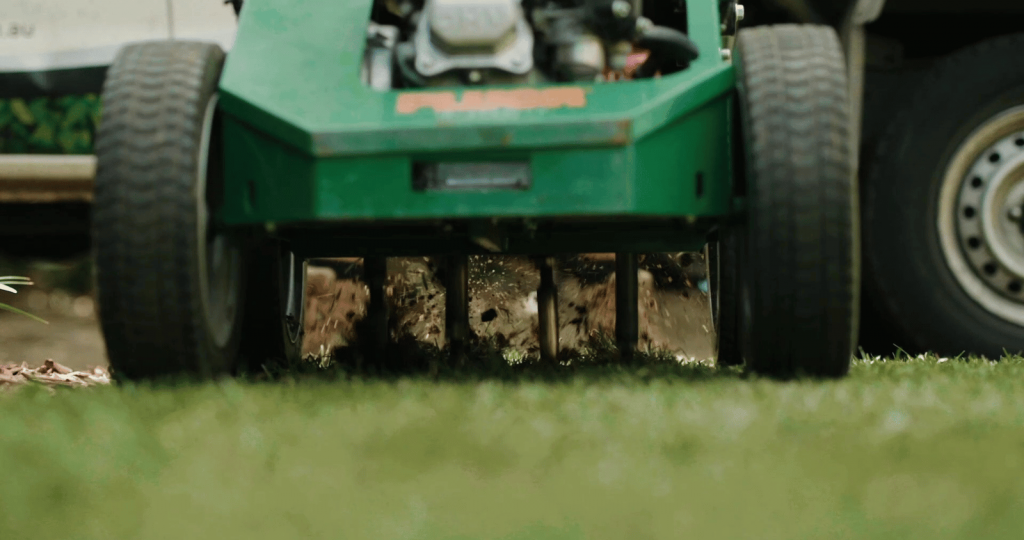
Yes, aerating your Buffalo lawn can be beneficial for its overall health and growth. Aeration is a process that involves creating small holes in the soil to help air, water, and nutrients penetrate the grass roots more easily. This can help to alleviate soil compaction, promote root growth, and improve the overall health of the lawn.
It’s generally recommended to aerate a Buffalo lawn at least once per year, preferably in the early spring or fall when the grass is actively growing. However, the frequency of aeration may depend on factors such as soil type, lawn usage, and weather conditions. If you’re unsure about whether to aerate your Buffalo lawn, it may be helpful to consult a lawn care professional for advice. Silverstone Gardening offers professional aeration services for Buffalo lawns.
Here is an article that may be helpful to you if you are considering aerating you buffalo lawn.
What diseases are common with buffalo lawns?
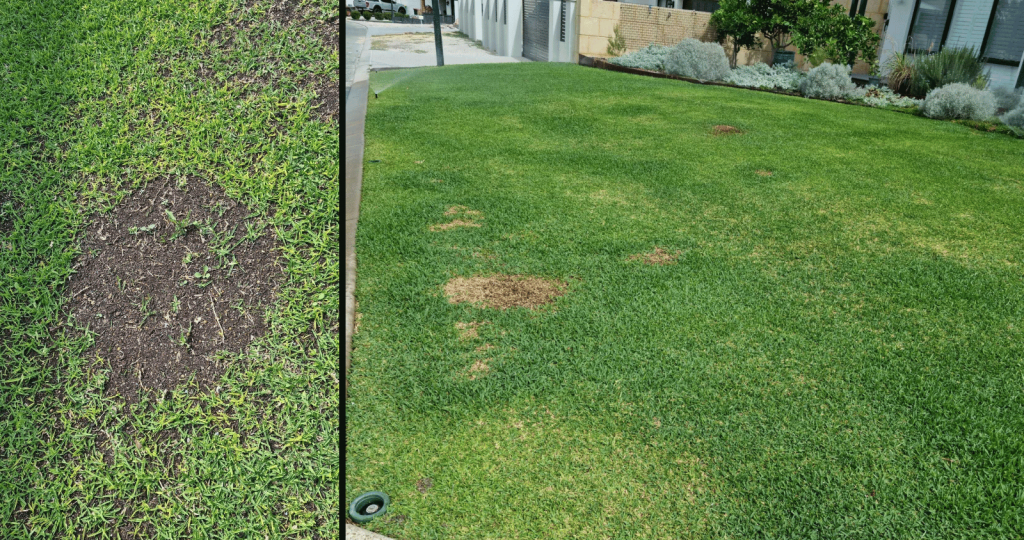
Buffalo lawns can be susceptible to several diseases, just like any other type of grass. Here are some common diseases that may affect Buffalo lawns:
- Brown Patch: This fungal disease can cause circular brown patches in the lawn, often surrounded by a yellow “halo” of dying grass. Brown patch is more common in warm, humid conditions and can be prevented by avoiding over-fertilisation and over-watering.
- Dollar Spot: This disease causes small, circular patches of dead grass that are about the size of a silver dollar. Dollar spot is often more prevalent in the spring and fall when temperatures are cooler and the grass is moist.
- Leaf Spot: This fungal disease causes small, dark spots on the leaves of the grass, which can merge together and create larger patches of dead grass. Leaf spot is more common in moist conditions and can be prevented by avoiding over-watering and providing adequate drainage.
- Fusarium Patch: This fungal disease causes irregular, circular patches of dead grass that can range in size from a few inches to several feet. Fusarium patch is more common in wet, cool conditions and can be prevented by avoiding over-watering and improving drainage.
Preventing these diseases in Buffalo lawns involves proper care, including regular mowing, watering, and fertilisation. It’s also important to avoid over-watering and over-fertilising, as these can create the moist, nutrient-rich conditions that many lawn diseases thrive in. If you notice any signs of disease in your Buffalo lawn, it’s important to take action quickly to prevent it from spreading and causing more damage.
What pests are common with buffalo lawns?
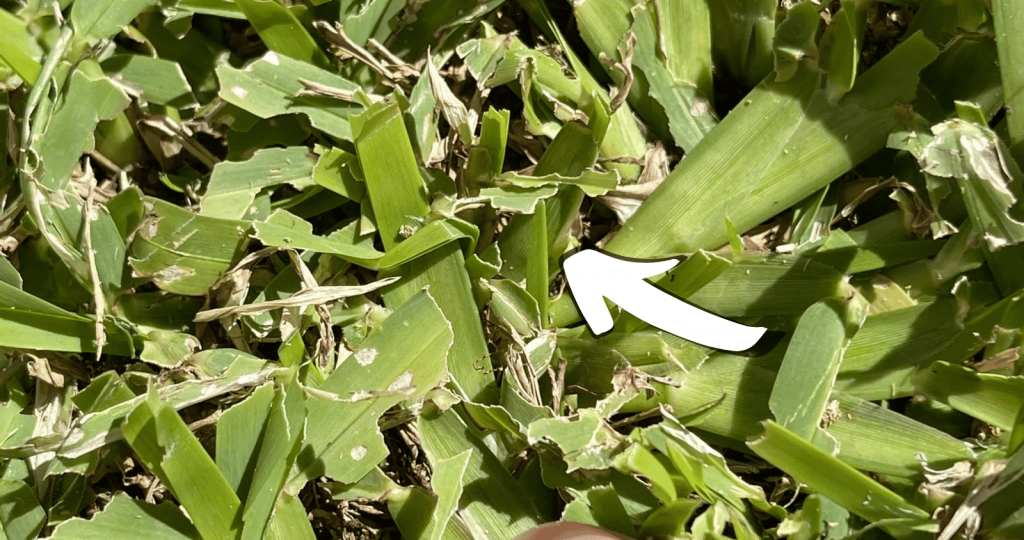
Buffalo lawns are susceptible to a variety of pests, just like any other type of grass. Here are some common pests that may affect Buffalo lawns:
- Armyworms: These caterpillars can cause significant damage to a Buffalo lawn by eating the grass blades and creating large brown patches. Armyworms are most active during the warmer months and can be controlled with insecticides.
- Sod Webworms: These caterpillars can cause damage to a Buffalo lawn by feeding on the grass blades and creating small, brown patches. Sod webworms are most active during the warmer months and can be controlled with insecticides.
- Mites: These tiny insects can cause the grass to turn yellow and appear dry, and can also cause webbing to form on the grass blades. Mites are most active during the warmer months and can be controlled with insecticides.
Preventing these pests in Buffalo lawns involves proper care, including regular mowing, watering, and fertilisation. It’s also important to avoid over-watering and over-fertilising, as these can create the moist, nutrient-rich conditions that many lawn pests thrive in. If you notice any signs of pests in your Buffalo lawn, it’s important to take action quickly to prevent them from causing more damage. A lawn care professional or pest control specialist can help identify the pest and provide the best course of action.
How to control weeds in Buffalo Lawns
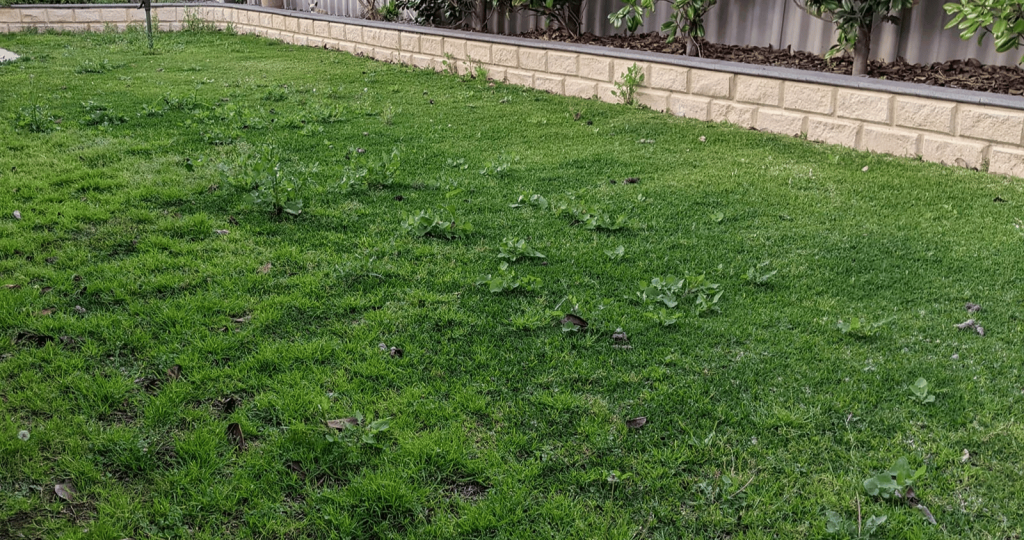
Controlling Broadleaf weeds in buffalo lawns
Broadleaf weeds are a common problem in all lawns, so if you don’t have any right now be assured that they will eventual come up in your Buffalo lawn.
There are two main ways to control weeds in your buffalo lawns. Manual removal and selective herbicides.
Manual removal involves physically pulling the weeds out of the lawn by hand. This is a labor-intensive process, but it can be effective for small areas of weeds. To manually remove broadleaf weeds, you should grasp the weed near the base and pull it out of the ground, making sure to remove as much of the root as possible.
Selective herbicides, such as Bin-Die and Bow and Arrow, are designed to kill broadleaf weeds while leaving the grass unharmed. These herbicides work by targeting the broadleaf weeds and not affecting the grass. It’s important to read and follow the instructions on the label carefully when using herbicides, as they can be harmful if not used correctly. Selective herbicides should be applied when the weeds are actively growing, and it’s important to avoid applying them during hot, dry weather.
Overall, a combination of manual removal and selective herbicides can be an effective way to control broadleaf weeds in a lawn. It’s important to maintain a healthy lawn through proper watering, fertilisation, and regular mowing to prevent weeds from taking over.
Controlling grass weeds in buffalo lawns
There are very few herbicides that will control grassy weeds, like winter grass, in established lawns once they have sprouted in your lawn. In these cases manual removal, or very expensive herbiceds, are often the only choice. However, there are other options that can prevent weeds in your lawns before they ever emerge.
Pre-emergent herbicides like Spartan and Barricade are designed to prevent weed seeds from germinating and growing into mature plants. These herbicides work by creating a barrier in the soil that prevents the weed seeds from developing roots and growing. Pre-emergent herbicides are typically applied before the weeds have a chance to germinate and become established in the lawn.
When using a pre-emergent herbicide timing is very important. Apply the herbicide in early Autumn and early Spring, before the weeds have a chance to germinate.
It is also very important to apply your pre-emergent herbicide as evenly as possible. To get the best results you will need to use a herbicide sprayer, and follow the instructions on the label carefully. Be sure to apply the herbicide when the soil is dry, and water the lawn lightly after application to help the herbicide penetrate into the soil.
It’s important to note that pre-emergent herbicides only prevent new weeds from germinating and growing, and will not kill existing weeds in the lawn. To control existing weeds, a post-emergent herbicide or manual removal may be necessary.
Overall, pre-emergent herbicides like Spartan and Barricade can be an effective way to prevent weeds in a lawn, but it’s important to read and follow the label instructions carefully and to apply the herbicide at the appropriate time to achieve the best results. If you’re unsure about how to use a pre-emergent herbicide in your lawn, consult with a lawn care professional for the best course of action.
